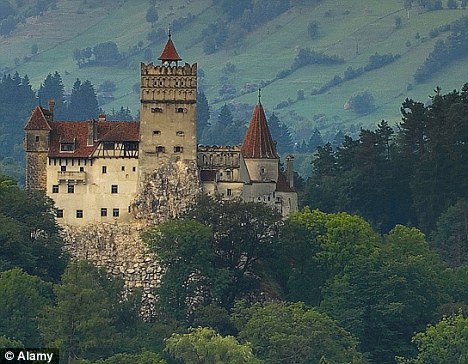
Mysterious: Bran Castle, home of Vlad the Impaler
– The Prince of Wales’s 10-year battle to protect Dracula’s home and his yearning for Transylvania (Daily Mail, Oct. 29, 2011):
The last thing I expected was for Prince Charles to crack a joke about being descended from Dracula.
But when I spoke to him for my new TV show Wild Carpathia, he told me he can trace his ancestry back, through his great-grandmother Queen Mary, to the half-brother of Vlad the Impaler, the inspiration for Dracula. Prince Charles seemed quite amused by his dark lineage.
A friend took him to visit the monastery, near Bucharest, where Vlad is buried and showed him his grave. ‘So I do have a bit of a stake in the country,’ he joked. Prince Charles has been visiting Transylvania – the home of his infamous ancestor – for more than a decade and feels passionately that it’s the last corner of Europe where there’s still a real balance between mankind and nature.
And it needs to be preserved, not just for its incredible biodiversity but because it nourishes the soul. To visit Transylvania (part of modernday Romania) and the Carpathian mountains is to enter a time warp. It’s one of the last great wildernesses in Europe, where bears, wolves and lynx roam a medieval land in which farmers and shepherds live as they’ve done for hundreds of years. Prince Charles has fallen in love with this place, and so have I.
When I travelled to Romania earlier this year to make the programme, we stayed in the remote village of Zalanpatak, in a 400-year-old farmhouse and barn that have been restored for HRH by his friend, Count Tibor Kalnoky.
The forest is just yards from the back door, and one teatime we saw two brown bears enjoying the last of the sunlight as they grazed in the meadow in front of the house. It was a magical moment.
Sadly, if we don’t preserve this landscape, there’s a danger it will disappear within the next ten years. ‘Transylvania has so much to teach us,’ Prince Charles told me. ‘It’s the last corner of Europe where we see true sustainability. We must learn from that before it’s too late.
‘People will say, “Oh, you’re trying to preserve things in aspic, you’re trying to prevent progress.” But you’d think by now we might have learned our lesson from all that’s gone wrong with the agroindustrial approach,’ he said, referring to the large-scale, highly mechanised production prevalent in farms today.
That’s why Prince Charles has been working with Count Tibor to restore some of these beautiful houses, not only to preserve local skills, but to promote responsible tourism so people have a means of supplementing their incomes. If you wander through villages like Viscri, now designated by UNESCO as a world heritage site, you see a landscape much like England was in the Middle Ages. Yet it’s a way of life that’s being destroyed.
From the air, you can see great swathes of deforestation. HRH kindly allowed us to film him at Birkhall, his home at Balmoral – because that’s the Carpathian landscape of the future if they continue cutting down trees at the present rate. The Scottish Highlands are undoubtedly beautiful, but they are barren. Yet this was once the ancient Forest of Caledon, with wolves, bears, lynx and European elk.
But bears and other big carnivores need vast tracts of wilderness, linked by corridors that let them migrate and move freely. The wilderness, on the other hand, needs large carnivores because they keep the ecosystem in balance. Without wolves at the top of the food chain, deer and chamois stray down from the mountains, damaging crops and the shoots of trees that support countless species of birds, butterflies and flowers.
In one Carpathian meadow you can find 60 different flowers in one square metre – I counted six different orchids alone. That’s because the land has never been fertilised or sprayed. And in May, when we were there, the high alpine pastures are a stunningly beautiful sea of white daffodils.
However, these days lots of villages have been abandoned and wonderful
houses and medieval fortified churches are crumbling into decay. After the fall of Communism, many Transylvanian families moved to the West, leaving everything behind. Those small farmers who remain are custodians of the landscape and their survival ensures the survival of this place. But they’re poor.Understandably, if they can’t get fair prices for what they produce by traditional methods, they’ll be tempted by intensive farming – with all that means for the environment. Prince Charles believes it’s vital that Transylvanian farmers continue living in harmony with the natural world – and that we in the West also put nature back at the heart of the way we produce our food.
‘The great thing about Transylvania,’ he told me, ‘is that unique relationship between man and his surroundings.’ Because that’s what’s missing from our own society. ‘People yearn for a sense of belonging, identity and meaning,’ he went on. ‘It’s in us but we’ve denied it anddiscarded it as if it’s irrelevant. It isn’t.’
See also:
– Prince Charles’s Income From Taxpayers Rises 18 Percent – Inflation? What Inflation?
– UK Government Orders Information Blackout On EU Farming Subsidies For The Royal Family
– Queen Tried to Use State Poverty Fund to Heat Buckingham Palace
History:
The British Royals since 1714 are coming from the House of Hannover and the House of Saxe-Coburg-Gotha. The Royals are ‘really’ Germans.
The royal family’s official name, or lack thereof, became a problem during World War I, when people began to mutter that Saxe-Coburg-Gotha sounded far too German. King George V and his family needed a new English-sounding name. After considering everything from Plantagenet to Tudor-Stuart to simply England, the king and his advisors chose the name Windsor.